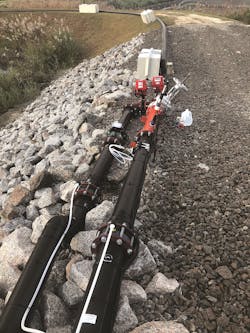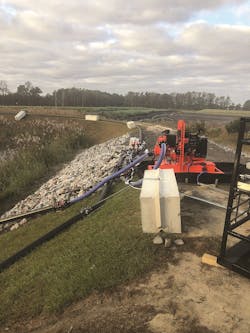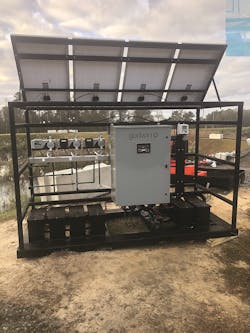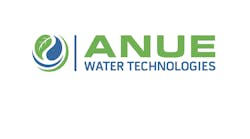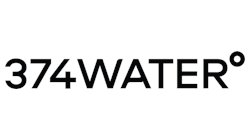Continuous, real-time TSS monitoring verifies effluent quality and coal ash management performance while reducing compliance costs
Dave Fraley, Chris Bauman and Dave Donahue
Reducing the cost and compliance burden associated with meeting final coal ash remediation effluent requirements continues to be a key driver to technical innovation. As many power plants continue to struggle with the critical last step in their coal ash remediation processes — the final testing phase — some plants have successfully adopted the use of recently advanced sensor technology to measure real-time total suspended solids (TSS) to verify their discharge water is meeting specified requirements.
TSS is the major parameter for assessing effluent quality in regulatory discharge permits for coal ash remediation. The necessity to consistently meet TSS discharge limits and avoid fines and other potential liabilities requires substantial field data collection, verification, documenting and reporting.
Testing Lag Time = Risk
Most coal combustion residuals (CCR) operations today either retain or release plant effluent based on laboratory TSS test results that require at least a day to complete but typically take at least two or three days. The existing TSS testing method for compliance verification is a time-consuming laboratory test that cannot currently be completed in the field, unless by mobile certified field labs. This inherent lag time between sampling and verification brings unknowns to the remediation process, often necessitating more field sampling and testing (erring on the side of over-compliance) than a plant’s permit requires. It also raises the potential for risky bottlenecks in overall remediation operations.
As part of their permit specifications, most plants have maximum allowable discharge flow rates — only a certain number of gallons can be discharged in any 24-hour period. The permitted discharge volume depends primarily upon the regulatory designation of the receiving stream and the characteristics of the plant’s wastewater effluent. Once a plant has met its allowable discharge for the day, pumps must be turned off until the next day.
These discharge permits typically contain both a daily limit and a monthly limit for TSS, and most remediation operations have established their own internal limit, or daily high, that is set far enough below the regulatory permit limit to provide a margin of protection against violations.
Many facilities have turned to this expensive and burdensome over-compliance strategy because of the significant lag time between gathering field samples and final laboratory TSS analysis. For example, a lab result from a sample pulled two days earlier shows TSS levels above the facility’s internally established limit or, worse, its permit limit. At this point, operations will stop discharging for an extended period of time to compensate. Because TSS monthly regulatory reporting is based on a time-weighted average, the plant receives a zero for days when pumps are off, thereby averaging out daily TSS levels to meet the monthly permit requirement.
Excessive zero days can lead to high containment levels that can further exacerbate the potential for serious issues such as a pond breach during hurricanes and other severe weather events. Additionally, when the facility needs to discharge its effluent but can’t, the retaining basin or pond fills up with more water that must be pumped. Due to its daily maximum allowable discharge limit, a plant cannot get those zero days back by increasing the pump schedule other days to make up the difference.
Depending upon the permits, some locations test TSS levels several times per day. Other locations test several times a week. In either case, testing requires manpower to pull samples. Plus, the facility must rely on an outside laboratory or perform the test in-house, which requires having a certified lab. To shave off some lag time, some facilities contract mobile certified labs to remain on site full time to handle effluent testing. Regardless of how lab tests are run, it’s an expensive and labor-intensive process.
Probe-Based, Real-Time TSS Measurement
To reduce these high costs and compliance risks, some coal-fired power plants have begun adopting advanced sensor technology to measure real-time TSS to verify their discharge water is meeting specified requirements.
TSS is a physical laboratory measurement; it defines the actual weight of suspended material in a given volume of water. The measurement derived from the optical sensor is not an absolute unit; however, TSS has a linear relationship with the scattering and backscattering coefficients of light. Light-scattering technology differentiates samples based on refractive index, size, shape and composition. Backscattering is a method of light scattering measurement that correlates with TSS. The field probe reads the light measurements as a suspended solids value based on the calibration against laboratory grab sample analysis.
Real-time, probe-based TSS monitoring eliminates the need for frequent extra sampling and laboratory testing. Along with reducing compliance risks and costs, coal-fired power plants are consistently preventing costly project delays resulting from lengthy lab analysis procedures.
Optimizing Performance
TSS in water can be detected by a number of optical sensing techniques, and it has been understood for many years that TSS and the backscattering coefficient correlate well. But early instruments using this method were met with limited success in harsh applications like coal ash remediation. Poor performance was due to shortfalls in electronics, light source and other materials of construction and control algorithm. Difficulty keeping the sensor’s lens clean while operating in real-world environments also contributed to sensing limitations of early units.
The pressures to meet new, increasingly stringent government regulations prompted YSI, a Xylem brand, to emphasize its research and development efforts toward further improving and stabilizing the backscatter method for TSS prediction. This also resulted in improved protection for the probe against interferences brought by severe operating conditions. By eliminating and compensating for the most common sources of instability, through the use of light-scatter and backscatter measurement methods, advancements in light-emitting diode (LED) technology, the development of a comprehensive algorithm to determine the relationship between measured TSS and predicted TSS, and an advanced sonic lens cleaning system, the IQ SensorNet ViSolid® Suspended Solids Probe, is now being used in harsh wastewater streams to consistently and accurately measure TSS in real time with a repeatability of <0.015 percent or >0.0006 percent FNU.
Because the sensor measures TSS concentrations in real time with consistent accuracy close to that of laboratory analysis, some operators have modified upstream processes, such as flocculant dosing, for higher treatment and remediation efficiencies. The long-term reliability of the measurement is also important for automation.
Automating Functions
Having the ability to monitor TSS in real time and obtain accurate results that are repeatable and verifiable with random lab tests enables users to automate functions such as controlling pumps transporting effluent, or start and stop pretreatment processes designed to keep effluent within permit guidelines.
Real-time TSS measurement, for example, can allow for automated polymer dosage control based on the probe’s continuous TSS measurements. If effluent TSS levels get too high, systems have been designed using the probe to automatically stop the transfer pump and instead recirculate the flow within the retaining pond while automatically dosing a flocculant, thereby making the solids further accumulate and drop out of solution. The same control system serving the TSS probe can also simultaneously measure pH (by adding a pH probe). If effluent pH is too high or too low, the controller can be programmed to turn on a small pump to add acid or base for pH adjustment to ensure upper and lower pH permit limits are being met.
Power plants traditionally rely on laboratories (including mobile labs) for TSS analysis and testing often requires extensive personnel for attaining samples in remote locations, sometimes multiple times a day. Online TSS monitoring significantly reduces this effort by enabling operators to log in remotely for monitoring or troubleshooting purposes.
An ‘Optical Fingerprint’
Accurate online, optical sensor-based TSS monitoring provides a real-time measurement of effluent TSS that can be used as an operation and management parameter for complying with regulatory requirements.
Continuous TSS measurement can also provide plant owners the potential for significant operational efficiencies and cost reductions. Sampling and laboratory testing exceeding the number of random samples required to meet permit are no longer necessary, freeing up workforce and laboratory costs. The long-term reliability of the measurement also allows for the automation of certain functions such as the control of transport pumps and valves, and to start and stop chemical pretreatment processes.
Additionally, real-time TSS monitoring can provide ongoing backup documentation, an optical fingerprint providing a real-time effluent discharge record that can substantiate compliance reporting and defend against potential legal action. It can also be used to demonstrate a plant’s good faith in exceeding its permit requirements, demonstrating the plant is being a good steward of the environment. IWW
About the Authors: Chris Bauman is a controls design engineer at Xylem and holds a chemical engineering degree from Rowan University.
Dave Donahue is an outside sales representative and former branch manager for Xylem Dewatering Solutions.
David Fraley is regional sales manager, southeastern United States, at Xylem. He holds a bachelor’s degree in conservation biology from the University of Idaho.
